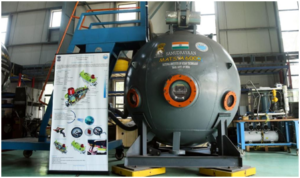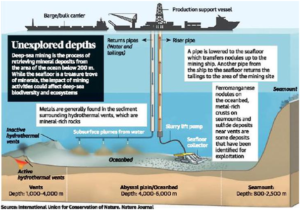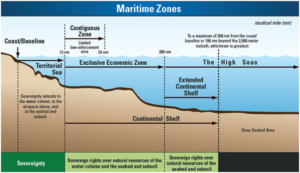
MATSYA 6000
MATSYA 6000
Recently the government revealed that as a part of Samudrayaan mission, a self-propelled manned submersible (MATSYA 6000) will carry 3 persons to a depth of 6000 meters for exploration of deep-sea resources.
- This mission is a part of India’s broader efforts to explore and utilize the resources present in the deep-sea environment.
About MATSYA 6000
- MATSYA 6000 is a self-propelled manned submersible being developed by the National Institute of Ocean Technology (NIOT), located in Chennai, India.
- The submersible is designed to carry three persons to a depth of 6000 meters in the ocean for the purpose of exploring deep-sea resources.
- Endurance and Capabilities:
- MATSYA 6000 has an endurance of 12 hours for normal operations.
- In case of emergencies, it can operate for up to 96 hours.
- The submersible is equipped to enable direct observation and collection of samples from the deep-sea environment, providing researchers with valuable insights into the ocean’s depths.
- Deep Ocean Mission (DOM):
- The MATSYA 6000 submersible is being developed as a part of the Deep Ocean Mission (DOM), which was announced in 2021.
- The Deep Ocean Mission is a comprehensive initiative aimed at exploring the deep-sea environment, harnessing its resources, and expanding our understanding of the ocean’s various aspects.
- Benefits and Applications:
- The development of MATSYA 6000 is expected to contribute to underwater engineering innovations.
- This includes applications such as asset inspection, underwater tourism, and promoting ocean literacy.
- By allowing humans to directly observe and collect samples from the deep sea, MATSYA 6000 can advance our understanding of the ocean’s biodiversity, geology, and various ecosystems.

About India’s Deep Ocean Mission
India’s “Deep Ocean Mission” was launched in 2019, focusing on exploring and extracting deep ocean minerals.
- Ministry of Earth Sciences announced a ₹8,000-crore plan to explore deep ocean minerals.
- The mission’s central objective is to explore and extract polymetallic nodules.
- The nodules are potato-like accretions containing minerals like manganese, nickel, cobalt, copper, and iron hydroxide.
- These nodules are found on the Indian Ocean floor at depths of about 6,000 meters and have potential applications in electronics, smartphones, batteries, and solar panels.
- Mining Area and Resource Potential:
- India’s deep-sea mining area was allocated by the International Seabed Authority (ISA), based on the 1982 United Nations Convention on the Law of the Sea.
- India was granted the status of a “Pioneer Investor” in 1987 and received an area of about 1.5 lakh sq km in the Central Indian Ocean Basin (CIOB) for nodule exploration.
- Following resource analysis, India retained an area of 75,000 sq km, estimated to have 380 million tonnes of polymetallic nodule resources containing nickel, copper, cobalt, and manganese.
- Global Competition and Mining Challenges:
- Other countries also participate in deep-sea mining, with identified areas like the Clarion-Clipperton Zone in the central Pacific Ocean.
- The ISA has contracts for exploration with 29 contractors from countries like China, France, Germany, Japan, South Korea, Russia, and small islands.
- India’s mining site is at a depth of 5,500 meters, with high pressure and low temperature conditions.
- The country has developed mining technology for these depths and aims to deploy mining machinery at 5,500 meters.
- Environmental Concerns and Guidelines:
- Deep-sea mining could have environmental consequences, impacting unique species adapted to harsh conditions.
- The deep sea’s biodiversity and ecology are not well understood, making it challenging to assess environmental impacts.
- Guidelines for exploration have been established, but new exploitation guidelines are being developed in discussions with the ISA.
- Concerns include sediment plumes harming filter feeders, noise and light pollution, and oil spills from operating vessels.
- Economic Viability and Scaling Up:
- ISA estimates that deep-sea mining would be commercially viable if around three million tonnes are mined annually.
- Further studies are being conducted to understand how the technology can be scaled up and used efficiently.

About International Seabed Authority (ISA)
- The International Seabed Authority (ISA) is an international organization established under the United Nations Convention on the Law of the Sea (UNCLOS).
- It has the mandate to regulate and manage activities related to the exploration and exploitation of mineral resources in the international seabed area beyond national jurisdiction.
- Functions:
- The ISA issues contracts to qualified organizations (contractors) for the exploration and exploitation of mineral resources on the seabed in accordance with UNCLOS regulations.
- The ISA sets rules and regulations to ensure the protection of the marine environment during exploration and exploitation activities.
- The ISA establishes a system for revenue sharing from mining activities.
- Pioneer Investor
- Some countries, like India, were granted “Pioneer Investor” status for being among the first to invest in deep-sea exploration and mining.
- This status gives such countries preferential treatment and an opportunity to secure areas of the international seabed for their exploration activities.
About United Nations Convention on the Law of the Sea (UNCLOS)
- The United Nations Convention on the Law of the Sea (UNCLOS) is a comprehensive international treaty that defines the legal framework for the use and conservation of the world’s oceans and their resources.
- It was adopted in 1982 after several years of negotiations and went into effect in 1994.
- UNCLOS is often referred to as the “constitution for the oceans” due to its extensive coverage of various maritime issues.
- Key Provisions:
- Territorial Waters: UNCLOS defines the territorial waters of coastal states, extending up to 12 nautical miles from their coastlines.
- Coastal states have sovereignty over these waters, subject to certain navigational rights for other states.
- Exclusive Economic Zones (EEZ): Coastal states have sovereign rights over the natural resources within an EEZ extending up to 200 nautical miles from their coastlines.
- Other states have the right to conduct certain activities in these zones, such as fishing and resource exploration.
- Continental Shelf:
- UNCLOS delineates rules for determining the outer limits of a coastal state’s continental shelf beyond its territorial waters,
- This provides a legal framework for the exploitation of mineral and other non-living resources.
- High Seas: UNCLOS outlines regulations governing activities in the high seas, which are beyond the jurisdiction of any single state.
- All states have the freedom of navigation, overflight, and the right to lay submarine cables and pipelines in the high seas.
- Environmental Protection: The convention places significant emphasis on the protection and preservation of the marine environment.
- It establishes principles for preventing pollution, regulating marine scientific research, and conserving marine living resources.
- Dispute Settlement: The convention establishes mechanisms for the peaceful settlement of disputes related to the interpretation and application of its provisions.
- This includes arbitration, international tribunals, and the International Court of Justice.
- Territorial Waters: UNCLOS defines the territorial waters of coastal states, extending up to 12 nautical miles from their coastlines.
